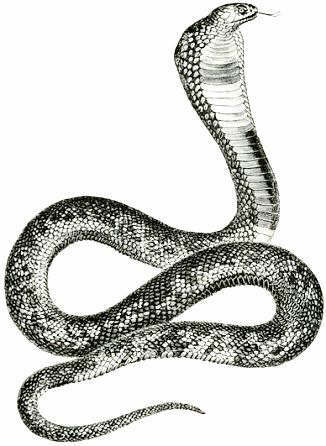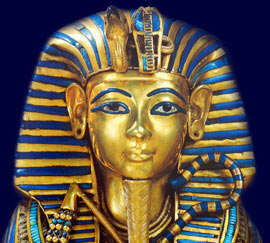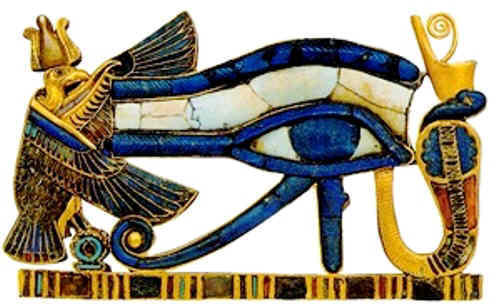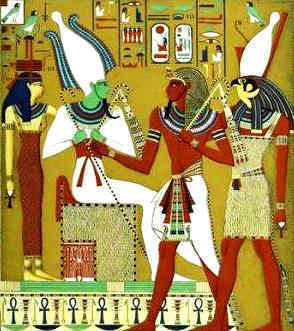
| The Uraeus | 
|
|
Ancient Egyptian Gods and Goddesses for kids - Uraeus, the Cobra Symbol The history of ancient Egypt and the significance of the Uraeus, the rearing cobra symbol |
|
Uraeus, the Cobra Symbol
Discover the history, mythology and beliefs surrounding the 'Uraeus' the rearing cobra symbol of Ancient Egypt. The Uraeus, the rearing cobra symbol was one of the most important Egyptian Symbols and frequently seen in images and pictures of ancient Egypt. The word Uraeus derives from the Egyptian word "iaret" meaning "risen one" from the image of a cobra rising up in protection. The Uraeus the cobra symbol was an emblem ancient Egyptian Gods and Pharaohs and strongly features in the paintings, images and Hieroglyphics of ancient Egyptian Pharaohs, gods and goddesses. The Uraeus, cobra symbol was a potent emblem of sovereignty, royalty and divine authority in ancient Egypt. |
|
Facts about the ancient Egyptian Uraeus, the Cobra Symbol
The Uraeus was an ancient Egyptian hieroglyph and its icon is depicted in art, artefacts, relics. Examples of the icon can be found in the tombs, temples and manuscripts of the ancient Egyptians. Look at the pictures and images contained in this, and other articles on ancient Egypt and you will see many depictions of the Uraeus, the rearing cobra symbol.
The Uraeus Cobra Symbol Fact File | Name: |
The Uraeus cobra symbol (plural uraei) derives from the Egyptian word "iaret" meaning "risen one" from the image of a cobra rising up in protection.
| | Description & Definition: | Description & Definition: It is described as a rearing cobra, asp or serpent represented on the front of the headdresses of gods and pharaohs as an emblem of supreme power and authority
| | Materials: | The materials used to make a Uraeus were made of precious metals such as gold, and less frequently silver, and decorated with precious jewels
| | Significance: | The sacred icon of the rearing cobra was depicted on the crowns and headdresses and reinforced the close connection between the pharaohs and the gods. The pharaoh was recognized by wearing the Uraeus cobra symbol, which conveyed legitimacy to the ruler
| | Symbol: | The Uraeus rearing cobra symbol was was one of the most potent symbols of ancient Egypt symbolizing the absolute power and authority of the gods and the Egyptian monarchy
| | Fetish: | The Uraeus cobra symbol was a fetish, an object that was believed to embody magical powers and offer magical protection
|
|
|
The Uraeus, the Rearing Cobra Symbol of the gods
The Uraeus is the cobra symbol for the goddess Wadjet, one of the earliest Egyptian deities, who often was depicted as a cobra. As a cobra, she spat poison at anyone who tried to vandalise or rob the royal tombs. The image of Wadjet (also called Edjo), and other such cobra or snake deities, was worn by the pharaohs as a headdress or crown, and represented her protection and as a claim over the domain of Egypt. Werethekau was also another name for the rearing cobra upon royal crowns and headdresses. Coiled bronze snake wands were said to represent the goddess Werethekau, whose name, like her epithet, was "Great of Magic." The Cobra Symbol in ancient Mythology and Religion
The both the religions and mythology of many cultures cobras serpents and snakes represent fertility or a creative life force. As snakes such as cobras shed their skin, they are symbols of rebirth, transformation, immortality, and healing. Snakes are represented as potent guardians of temples and sacred sanctuaries. Their connection with protectors and guardians might originate in the observation that when threatened, some snakes, especially the cobra, frequently hold and defend their ground, first resorting to threatening display and then fighting, rather than retreating. 
Sacred Uraeus Rearing Cobra The Uraeus cobra symbol, the Gods and the Pharaohs
The following pictures of the Uraeus cobra symbol depicts the variety of headdresses and crowns to which the emblem is attached. The picture of the Goddess Mut, the mother goddess depicts the Uraeus cobra symbol attached to a vulture headdress which is worn beneath the Pshent, the red and white double crown that represented a unified Egypt. The picture of the death mask of Tutankhamen depicts the famous pharaoh wearing the striped Nemes headdress of a Pharaoh fronted by the Uraeus cobra symbol. The picture of the Goddess Hathor shows the emblem attached to the cows horn and sun disk headdress. | | 
| | | | Tutankhamen
with the Cobra Symbol | |
|
|
Uraeus- Interesting research information and Facts about the Egyptian Uraeus, the Cobra Symbol
- The sacred regalia of ancient Egyptians - the cobra symbol
- History and Egyptian Mythology associated with Uraeus, the rearing Cobra Symbol
- Facts and information about the gods and deities of of classical Egypt for schools, research and kids
- Pictures, Description and description of the rearing Cobra Symbol for kids
|
| | |
|
The Uraeus Cobra Symbol & the 'All-Seeing' Eye of Horus
The centre of the next picture features the Eye of Horus that is also called the All-seeing Eye and the Wadjet. The eye is flanked by Nekhbet the winged vulture goddess representing Upper Egypt and Wadjet the cobra goddess representing Lower Egypt. Once again the Uraeus represents a highly prominent role in the picture as a full size cobra crowned by the double crown of a unified Egypt. 
Facts about the Uraeus, the Cobra Symbol, in Egyptian Mythology and History
Discover interesting information and research facts about the Uraeus, the iconic Egyptian cobra symbol. The facts about the Uraeus rearing cobra symbol provides a list detailing fascinating additional info to increase your knowledge about the Uraeus in Egyptian Mythology and history. Facts about the Uraeus, the Cobra Symbol from Mythology
and Egyptian History |
Fact 1: |
The protective role of the uraeus is incorporated in scenes depicted in the Book of the Dead, associating the uraeus cobra symbol with the underworld (Duat)
| | Fact 2: | The cobra symbolized both divine protection and enlightenment
| | Fact 3: | The shape of the Uraeus resembles a letter S, and is depicted with two curves along the body of the cobra
| | Fact 4: | The sign of the Uraeus was also used to symbolize water in ceremonies and rituals relating to purification
| | Fact 5: | In further reference to the picture of the 'all-seeing eye', when the two halves of Egypt united, the uraeus blended with the vulture, which was the symbol of Upper Egypt.
| | Fact 6: | In 1889, the English Egyptologist Flinders Petrie found "a marvellous gold and inlaid royal uraeus". The stunning Golden Uraeus is made of solid gold, has black eyes of granite, a cobra head of lapis lazuli with carnelian and turquoise inlays
| | Fact 7: | The Uraeus cobra symbol was easily recognised in hierolglyphics 
| Facts about the Uraeus, the Cobra Symbol from Mythology
and Egyptian History |

|
|
|
|